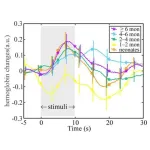(Press-News.org) Almost US$7 trillion per year in government subsidies and private investment - around 7 per cent of global GDP - has a direct negative impact on nature.
Nature-based solutions remain dramatically underfunded. Current public and private finance flows are only US$200 billion per year. To meet climate, biodiversity, and restoration targets, this needs to triple by 2030 and quadruple by 2050.
Realignment of public and private nature-negative finance flows is urgently needed
Dubai, 9 December 2022 – Close to $7 trillion is invested globally each year in activities that have a direct negative impact on nature from both public and private sector sources - equivalent to roughly 7 per cent of global Gross Domestic Product (GDP) - according to the latest State of Finance for Nature report released today at COP28 by the UN Environment Programme (UNEP) and partners.
The report finds that in 2022, investments in nature-based solutions totaled approximately $200 billion, but finance flows to activities directly harming nature were more than 30 times larger. It exposes a concerning disparity between the volumes of finance to nature-based solutions and nature-negative finance flows, and underscores the urgency to address the interconnected crises of climate change, biodiversity loss, and land degradation.
“Nature-based solutions are dramatically underfunded. Annual nature-negative investments are over 30 times larger than financing for nature-based solutions that promote a stable climate, and healthy land and nature. To have any chance of meeting the sustainable development goals, these numbers must be flipped – with true custodians of the land, such as Indigenous Peoples, among the chief beneficiaries,” said Inger Andersen, Executive Director of UNEP.
The findings are based on an analysis of global financial flows, revealing that private nature- negative finance flows amount to US$5 trillion annually, 140 times larger than the US$35 billion of private investments in nature-based solutions. The five industries channeling most of the negative financial flows – construction, electric utilities, real estate, oil and gas, and food and tobacco – represent 16per cent of overall investment flows in the economy but 43per cent of nature-negative flows associated with the destruction of forests, wetlands, and other natural habitats.
Niki Mardas, Executive Director of Global Canopy said, “This year’s report is a stark reminder that continuing with “business as usual” poses a severe threat to our planet, reinforcing the urgent need for a transition to sustainable business practices and to stop the financing of nature destruction. The net is tightening, with increased regulatory pressure in key areas like tackling deforestation, it means that those companies and financial institutions still driving the problem now need to make best use of the excellent data, guidance and frameworks already available to urgently commit to a nature-positive future."
Government spending on environmentally harmful subsidies in four sectors - agriculture, fossil fuels, fishery, and forestry - is estimated at US$1.7 trillion in 2022. As leaders gather in Dubai this week, reforming and repurposing environmentally harmful subsidies, particularly to fossil fuels and agriculture, will be critical. Fossil fuel subsidies to consumers alone doubled from US$563 billion in 2021 to US$1.163 billion in 2022.
Finance gap persists
The report identifies a significant financing gap for nature-based solutions, with only US$200 billion allocated in 2022, led by governments, who contributed 82 per cent (US$165 billion), while private finance remains modest at US$35 billion (18 per cent of total nature-based solutions finance flows). To meet the Rio Convention targets on limiting climate change to 1.5C, as well as the Global Biodiversity Framework target to set aside 30 per cent of land and sea by 2030 and achieve land degradation neutrality, finance flows to nature-based solutions must almost triple from current levels (US$200 billion) to reach US$542 billion per year by 2030 and quadruple to US$737 billion by 2050.
Both public funding and private investment need to increase dramatically, in conjunction with the re-alignment of finance flows that have a detrimental impact on nature. While public funding will continue to play a critical role, private finance can potentially increase its share of nature- based finance from 18 per cent currently to 33 per cent by 2050.
“The widespread degradation of nature is not only exacerbating the climate crisis but also pushing us towards exceeding planetary boundaries. Investing in nature-based solutions provides a strategic and cost-effective avenue to address the interconnected challenges of climate change, biodiversity loss, and land degradation while at the same time making tangible headway towards the sustainable development goals,” said Jochen Flasbarth, State Secretary in the German Federal Ministry for Economic Cooperation and Development, which funded the report.
Nature-based solutions provide critical investment opportunities, as they are cost-effective and provide multiple benefits. Investment opportunities in sustainable land management can increase fourfold by 2050 based on the long-term profitability of sustainable food and commodity production - critical to catalyze private investment. Protection of diverse ecosystems is highly cost-effective, representing 80 per cent of the additional land needed for nature-based solutions while absorbing just 20 per cent of additional nature-based solutions financing by 2030. Given the scale of degradation globally, restoration provides massive opportunities to strengthen ecosystem function and resilience to deliver the ecosystem services that people rely so heavily upon.
Urgent action on two fronts: Repurposing nature negative finance and scaling investment in nature
The report suggests that simply doubling or tripling investment in nature-based solutions will not be sufficient to reach the three Rio targets unless the almost $7 trillion finance flows to nature-negative practices are dramatically reduced and ideally repurposed in favor of nature.
A major turnaround for nature is needed. The financial sector and businesses must not only increase investments in nature-based solutions but also implement incentives to redirect finance from harmful activities, fostering positive outcomes for nature. Government policies play a crucial role in creating an enabling environment for nurturing investment opportunities. Notably, investment prospects in nature-based solutions are flourishing, driven by the overhaul of global sectors such as food, extractives, real estate, and infrastructure—major contributors to nature's decline. These opportunities rival those arising from the climate crisis, presenting a pivotal moment for impactful change.
NOTES TO EDITORS
About the UN Environment Programme (UNEP)
UNEP is the leading global voice on the environment. It provides leadership and encourages partnership in caring for the environment by inspiring, informing and enabling nations and peoples to improve their quality of life without compromising that of future generations.
About Global Canopy
Global Canopy is a data-driven environmental organisation that targets the market forces destroying nature. We provide innovative open-access data, clear metrics, and actionable insights to leading companies, financial institutions, governments, and campaigning organisations worldwide to help them make better decisions about nature, forests and people. globalcanopy.org
About the Economics of Land Degradation (ELD)
ELD is a global initiative aimed at integrating the true value of land into decision-making processes and promoting sustainable land use. The initiative was launched in 2011 by the German Federal Ministry for Economic Cooperation and Development (BMZ), the United Nations Convention to Combat Desertification (UNCCD) and the European Commission.
For more information, please contact:
News and Media Unit, UN Environment Programme
Aurelia Blin, Climate Finance Unit, Ecosystem Division, UN Environment Programme
Amy Fairbairn, Director of Strategic Communications, Global Canopy
END
Global annual finance flows of $7 trillion fueling climate, biodiversity, and land degradation crises
2023-12-09
ELSE PRESS RELEASES FROM THIS DATE:
Tracing how the infant brain responds to touch with near-infrared spectroscopy
2023-12-09
Tokyo, Japan – Researchers from Tokyo Metropolitan University have measured how oxygenated hemoglobin levels in the blood change in infants’ brains in response to touch. Using spectroscopy methods with external sensors placed on the scalp of sleeping infants, they found that the time at which levels peak doesn’t change with infant age, but the amount by which it varies over time does. Insights like this shed light on how the physiology of infants develop.
The first phase of a newborn’s life is a dazzling array of rapid developmental ...
These are the world's most effective charities
2023-12-09
Which charities will be most effective in ensuring your donation is put to good use? For the first time in the Netherlands, researchers applied scientific methods to pinpoint which charities achieve the most with the donations they receive. The University of Amsterdam and Stichting Doneer Effectief (Donate Effectively Foundation) unveiled the list on Friday, 8 December, during a sold out evening in Rotterdam. ‘We are talking about the Champions League of good causes,’ says professor of Philanthropy & Sustainable Investment Paul Smeets of the University of Amsterdam. The ranking ...
When is an aurora not an aurora?
2023-12-08
The shimmering green, red and purple curtains of the northern and southern lights — the auroras — may be the best-known phenomena lighting up the nighttime sky, but the most mysterious are the mauve and white streaks called Steve and their frequent companion, a glowing green "picket fence."
First recognized in 2018 as distinct from the common auroras, Steve — a tongue-in-cheek reference to the benign name given a scary hedge in a 2006 children's movie — and its associated picket fence were nevertheless thought to be caused by the same physical processes. But scientists were left scratching their heads about how these glowing emissions ...
Advisory panel issues field-defining recommendations for US government investments in particle physics research
2023-12-08
The High Energy Physics Advisory Panel (HEPAP) to the High Energy Physics program of the Office of Science of the U.S. Department of Energy and the National Science Foundation’s Division of Physics has released a new Particle Physics Project Prioritization Panel (P5) report, which outlines particle physicists’ recommendations for research priorities in a field whose projects — such as building new accelerator facilities — can take years or decades, contributions from thousands of scientists, and billions of dollars.
The 2023 P5 report represents the major activity in the field of particle physics that ...
Doctors discover many patients at UNC’s Inflammatory Bowel Disease Clinic screen positive for malnutrition
2023-12-08
CHAPEL HILL, NC — Eating food and absorbing its nutrients is an everyday occurrence, but this normal activity can look different for someone who suffers from inflammatory bowel disease. IBD, which includes Crohn’s disease and ulcerative colitis, can cause chronic inflammation of the digestive tract – which for many reasons can lead to malnutrition. This malnourished state is associated with an increased risk of morbidity and mortality, and new findings show that many patients in IBD clinic screen positive for malnutrition, leading to the critical need for same-day ...
BNL: Advisory panel issues field-defining recommendations for U.S. government investments in particle physics research
2023-12-08
The following news release on the 2023 Particle Physics Project Prioritization Panel (P5) report is based on one issued today by the American Physical Society (APS) with added content specific to the U.S. Department of Energy’s (DOE) Brookhaven National Laboratory. For more information about Brookhaven Lab’s research in particle physics, contact: Karen McNulty Walsh, kmcnulty@bnl.gov, (631) 344-8350. For APS media inquiries, contact Anna Torres, torres@aps.org, (301) 209-3605.
WASHINGTON, ...
International collaboration uses faculty member’s research on ancient Roman migration, seeks to understand Balkan genomic history
2023-12-08
STARKVILLE, Miss.––A Mississippi State University anthropologist’s bioarchaeological analysis and bone samples from ancient Roman burial sites were crucial in the development of new research regarding Roman and Balkan migration featured this week in Cell, a prestigious peer-reviewed journal.
Anna Osterholtz, an associate professor in the Department of Anthropology and Middle Eastern Cultures, provided her research on the “lived experiences” of the Romans in Croatia. She currently works closely with museum ...
USF Health Heart Institute doctors are upbeat about cardiac regeneration
2023-12-08
But when those batteries – heart muscle cells called cardiomyocytes − short circuit and die, the damage can be devastating. The damage to the heart muscle is usually permanent, leaving the heart unable to pump the way it should.
That’s the subject of a new study by a team that includes two USF Health doctors who reported their findings in Circulation, the flagship journal of the American Heart Association.
“An injury like a heart attack creates a massive loss of cardiomyocytes, and you can’t renew them,’’ said Da-Zhi Wang, PhD, director of the Center for Regenerative Medicine in the USF Health Heart Institute and Morsani College ...
AI-driven breakthroughs in cells study: SFU-UBC collaboration introduces "MCS-detect" for advancements in super-resolution microscopy
2023-12-08
In 2014, the Nobel Prize in Chemistry celebrated the breakthroughs in super-resolution microscopy, a technology that allows us to capture highly detailed images of small parts of cells using fluorescent microscopy. Despite its success, the resolution of super-resolution microscopy still can’t show tiny distances between organelles in cells. This gap is where Artificial Intelligence (AI) and Biomedical Computer Vision intersect, as researchers from SFU Computing Science and UBC School of Biomedical Engineering and Life Sciences Institute reveal how AI enhances super-resolution microscopy ...
Advisory panel issues field-defining recommendations for investments in particle physics research
2023-12-08
Contributions from Argonne will drive innovation in particle physics and shed light on outstanding mysteries in the field.
Yesterday marked the release of a highly anticipated report from the Particle Physics Project Prioritization Panel (P5), unveiling an exciting new roadmap for unlocking the secrets of the cosmos through particle physics.
The report was released by the High Energy Physics Advisory Panel to the High Energy Physics program of the Office of Science of the U.S. Department of Energy (DOE) and ...



